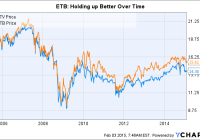Closed End Funds: Total Return Or NAV Return?
Closed-end funds are simple in concept, but complicated in practice. The big confusion comes from the frequent focus on distributions. While I believe distributions are strength for CEFs, they can also be a weakness. Closed-end funds, or CEFs, are something of an unloved stepchild in the pooled investment industry. Open-end mutual funds and exchange traded funds are the fair-haired children. But the lack of love paid to CEFs is really part of the appeal. Only you have to come to terms with how you want to measure CEF success. Returns When it comes to tracking pooled investment products you generally look at total return. This means including reinvested distributions into the performance equation. It makes sense to do this since CEFs, open-end mutual funds, and exchange traded funds are pass-through investments, meaning they have to send along any income or capital gains to shareholders. Calculating returns as if those distributions were put back to work is a simple method for including these distributions into returns and is a basic industry norm. Indeed, total return facilitates comparing funds to each other on an apples to apples basis. So, when looking at a CEF, you should consider more than just price performance. In fact, many CEFs focus on paying out large distributions. That leaves their net asset values, or NAVs, stagnant even though investors are receiving notable returns. A good example is Eaton Vance Tax-Managed Buy-Write Income Fund (NYSE: ETB ). ETB’s NAV at the start of 2010 was $15.59 a share. At the end of 2014 it was $16.31 a share. That’s an increase of 4.6% over five years. On the surface that sounds pretty abysmal. However, the fund distributed $6.98 per share over that span. Including this information completely changes the equation. And that’s why it’s important to look at total return and not just NAV. Complicating this is that CEFs trade on exchanges like stocks, but operate like mutual funds. And that leads to premiums and discounts to net asset value. Your results will be based on the market price, but when examining how a CEF is doing, you’ll want to look at NAV performance. Why? Market prices for CEFs are based on supply and demand, meaning investor sentiment rules the day. NAV is the actual performance of the portfolio. It’s a truer picture of management’s ability. But don’t forget NAV That said, you can’t forget about NAV and just look at total return. And distributions are, again, the reason. One of the big fears in the closed-end space is so-called destructive return of capital. This happens when a CEF pays out distributions while its NAV is falling. Over short periods of time this can provide shareholders with steady income, but over longer periods it can destroy a fund’s capital base and, thus, it’s ability to maintain distributions. On this front, take a look at Dreyfus High Yield Strategies Fund (NYSE: DHF ). In March 2011, the fund’s NAV was $4.08 a share. (The fund’s fiscal year ends in March.) By March 2015 the NAV had fallen to $3.84 a share. It paid out $2.22 a share in distributions over that span, producing a decent total return. However, looking beneath that, the distribution has fallen in each of the last five fiscal years. DHY’s distribution has gone from $0.52 a share in fiscal 2011 to $0.36 a share in fiscal 2015. So, yes, the fund’s trailing total returns aren’t bad. Yes, it still offers a notable yield. But the fund is getting smaller and smaller and so is the distribution. There are multiple reasons for this. One is that DHY is a high-yield fund dealing with an unusual low-rate world. So as bonds mature they are replaced with lower yielding fare. That said, with fewer assets in the fund, DHY is also hampered by the not so small fact that it can’t buy as many bonds as it could just a few years earlier. So this example shows that there are times when total return isn’t enough of a picture to decide on a CEF investment. Income for life The need to examine both total return and NAV is particularly important if you are an investor looking to live off the income your portfolio generates. In this situation you won’t be reinvesting your dividends, you’ll be spending them. And, thus, total return may be the best way to compare funds to each other, but it won’t be indicative of your portfolio’s performance or, more to the point, how long your money will last you. If your capital continues to decline over time because your CEFs pay out notable distributions that you spend while their NAVs are falling, you are in a much weaker position than total return alone might suggest. Which is exactly why destructive return of capital is such a buzz phrase. CEFs are a complex space and require a bit more thought than open-end mutual funds or exchange traded funds. And while their distributions often make them stand out from other pooled investment vehicle choices, you can’t just look at them from one angle and be done with it. So, look at total return and watch NAV. The stories each metric tells is important. Disclosure: I/we have no positions in any stocks mentioned, and no plans to initiate any positions within the next 72 hours. (More…) I wrote this article myself, and it expresses my own opinions. I am not receiving compensation for it (other than from Seeking Alpha). I have no business relationship with any company whose stock is mentioned in this article.
